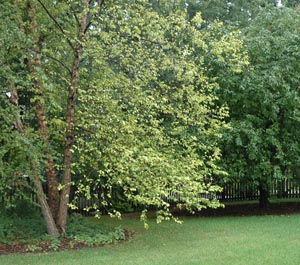A Few Overlooked Tree Selection Tips | |
|---|---|
| September 11, 2007 | |
|
As we enter the fall tree-planting season, many ask for advice on tree selection. Extension has plenty of advice in that arena, but I have a few additional tips from the viewpoint of a plant pathologist and one with years of experience looking at plant problems. My concern has to do with hidden costs, usually associated with disease or insect management. I would not claim that any tree is 100% free of diseases, insects, or environmental stress; but there are some that certainly have problems in Illinois. Take the example of Scotch (Scots) pine. This tree is grown in much of the state and often looks remarkably well. It is also very susceptible to pine wilt, a disease that often hits when the tree has attained a nice size and is about 20 years old. Diplodia blight is also a problem. Diplodia won’t kill the tree, but you will spend considerable time and money keeping dead wood cut out of the tree, raking up fallen cones on which the fungus overwinters, and possibly spraying to protect new growth. I do enjoy a healthy Scotch pine, but I also realize the possible risk down the road, at least in Illinois. River birch has become the replacement tree for borer-prone white birch. For a few years, it looked wonderful in my backyard. Now, the clay subsoil, poor drainage, and alkaline conditions leave my older birch with chronic chlorosis, as seen in the image.  The tree is still alive, but it requires extra irrigation and acidic fertilizer to keep it healthy—more added, hidden costs. Red maple may have some cultivars that look nice in Illinois, but most develop small, chlorotic foliage and many aboveground roots by the time the tree is about 15 years old. Red maple thrives in wetlands with well-drained, loose, slightly acidic soil. Fortunately, it is tolerant of many soil types, because ideal conditions do not match too many Illinois landscape planting sites. Thinking about planting a new tree in your landscape? The standard checklist to consider includes cold hardiness, mature size, form, tendancy to drop litter, and ornamental features. Here is something more to consider. Check around the neighborhood. Look for the trees you want to plant. Look for both young and old examples. Ask your neighbors how the trees have fared. Do they have to do much to maintain the beauty of the tree? Are there old trees of that species in your area, or do they die young? Check out the species online for reported problems, not just diseases but also insect and environmental problems. It is best to check sites that refer to plants in your area. Arboretums, botanic gardens, and university sites often describe conditions that species prefer. Books such as Michael Dirr’s Manual of Woody Landscape Plants are invaluable in this regard. A few Web sites with helpful information on plant selection include: http://woodyplants.nres.uiuc.edu/ http://www.mortonarb.org/ http://www.mobot.org/ http://www.chicago-botanic.org/ http://www.chicagolandgrows.org/index.php |